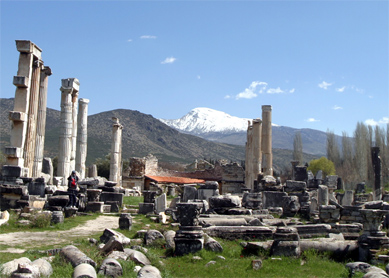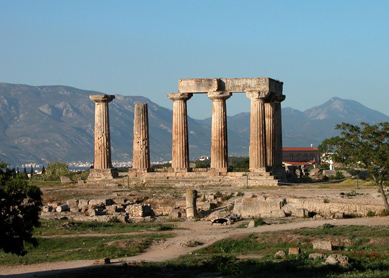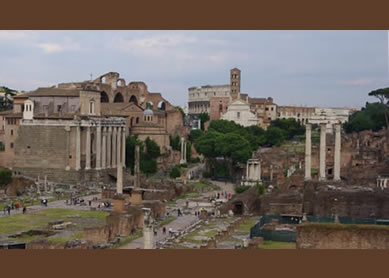Sardis was the capital of the Lydian Empire and exerted regional influence in Asia Minor (modern Turkey) throughout the Hellenistic, Roman, and Byzantine periods. Archaeology demonstrates a significant Jewish population into the seventh century CE. A late first-century community in Sardis is addressed in the Revelation of John, which was eventually included in the New Testament.
What do we know about Sardis at the time of Revelation?
The Revelation of John begins with letters to seven assemblies (ekklēsiai, often translated as churches) in western Asia Minor. Sardis is the fifth assembly addressed by the Son of Man, an enigmatic figure often read as Jesus (
This passage uses images of death, sleep, and defilement to exhort the Sardian community to life, alertness, and renewal. Because it is so rhetorically stylized, the explanations for these characterizations can only be conjectural. Some commentators read the Son of Man’s warnings to Sardis as indications of widespread spiritual apathy in the assembly while a few Sardians—metaphorically clothed in white—persist in holiness (see W. M. Ramsay and Ben Witherington III).
Attempts to connect these themes more directly to the general history of Sardis have often misfired. Until archaeological excavations began in 1958, the most available sources for ancient Sardis were Hellenistic literature (Herodotus’s Histories [440 BCE]; Aeschylus’s The Persians [472 BCE]) and the Lydian tumuli (monumental burial mounds) dotting the landscape. Because evidence for ancient Sardis dropped after the Hellenistic period, biblical commentators assumed the prominence of Sardis dropped too. They described a Sardis that was the glorious capital of the Lydians and the first city to mint coins but that had since fallen into decay. This story of rise-and-fall corroborated and extended Revelation’s emphasis on death and malaise (see especially Ramsay’s comments, who set the tone for following commentaries).
Recent archaeological research, however, has unearthed a healthy city that collaborated effectively with the Roman imperial regime during the time of the apostles. Sardis recovered well from a devastating earthquake in 17 CE through tax breaks and imperial investments, demonstrated by new monumental architecture like a massive bath-gymnasium complex (late second to early third century CE), the largest known Roman arch (first to second century CE), an imperial cult temple in the town center (mid first century CE), and second-century CE renovations to the Temple of Artemis. From Revelation we know that an ekklēsia existed in Sardis at the end of the first century CE; from archaeology, we see first-century Sardis about to hit another stride.
What can archaeology tell us about religious practice in Sardis?
From temples, temple renovations, coinage, and statuary, we can see that there was a thriving imperial cult and ongoing devotion to the goddesses Cybele and Artemis. Although Revelation evinces an ekklēsia at Sardis in the first-century, the assembly is not evident in the material record until much later. To date, four church buildings have been identified at Sardis from the fourth century and afterward. Meanwhile, the earliest extracanonical textual evidence of Christians in Sardis is from the late second century. Bishop Melito of Sardis (d. ca. 180 CE) is known to us from citations by early Christian writers Tertullian and Jerome, and his voice endures in the anti-Jewish homily On the Pascha.
The Jewish community so hated by Melito, however, is well attested in the material record. Jews may have settled in the city as early as the sixth century BCE if Obadiah’s mention of Sepharad is Sardis (Obad 1:20). Safer is Josephus’s claim that the Seleucid emperor Antiochus III forcibly resettled some Jews in Asia Minor (possibly including Sardis) during the third century BCE (Ant. 12.148-153, 259-261). Whatever the case, by the first century BCE, Josephus bears witness to a vibrant Jewish community in Sardis that is both civically integrated and strongly individuated, interfacing with the emperor and the Sardis city council while maintaining distinctive cultural traditions.
In the archaeological records, menorot (plural for menorah, a ritual branched candlestick in Jewish symbol and practice) abound, even in contexts literally next door to seemingly Christian neighbors. A fourth-century synagogue occupies the southeastern wing of the bath-gymnasium complex—the largest diaspora synagogue known. This monumental and centrally located synagogue holds rich mosaics, inscriptions in both Greek and Hebrew, and imagery that resonates with both Jewish and Sardian identities, like stone table pedestals in the shapes of lions. Donors describe themselves in dedicatory inscriptions as citizens of Sardis (Sardianoi), members of the city council (bouleutēs), and god-fearers (theosebeis), a term often used for gentile sympathizers within Jewish congregations. The grand synagogue is even more remarkable because its renovations date from a period when Christianity has been assumed to be ascendant or even dominant in Asia Minor. (On dating disputes, see Jodi Magness and Marcus Rautman.)
The material ecosystem of Sardis, then, shows a religiously plural city in which groups remained distinct from each other, worked alongside each other, strategically invested in each other, and jockeyed for civic influence through recourse to imperial authority, monumental architecture, building furnishings, and graffiti. While these traces don’t always highlight early Christian activity, they help us understand some of the strategies at play in religious coexistence and contestation at Sardis during the Roman period.
Bibliography
- Magness, Jodi. “The Date of the Sardis Synagogue in Light of the Numismatic Evidence.” American Journal of Archaeology 109.3 (2005): 443-475.
- Pedley, John Griffiths. Ancient Literary Sources on Sardis. Cambridge, MA: The President and Fellows of Harvard University, 1972.
- Rautman, Marcus. “Sardis in Late Antiquity.” Pages 1–26 in Archaeology and the Cities of Asia Minor in Late Antiquity. Edited by Ortwin Dally and Christopher Ratté. Kelsey Museum Publication 6. Ann Arbor, MI: Kelsey Museum of Archaeology, 2011.
- Kroll, John H. “The Greek Inscriptions of the Sardis Synagogue.” Harvard Theological Review 94 (2001): 5-55.
- Ramsay, William M. The Letters to the Seven Churches of Asia and Their Place in the Plan of the Apocalypse. London: Hodder and Stoughton, 1904.
- Witherington III, Ben. Revelation. New Cambridge Bible Commentary. Cambridge, UK: Cambridge University Press, 2003.
- Hanfmann, George, ed. Sardis from Prehistoric to Roman Times: Results of the Archaeological Exploration of Sardis, 1958-1975. Cambridge, MA: Harvard University Press, 1983.





